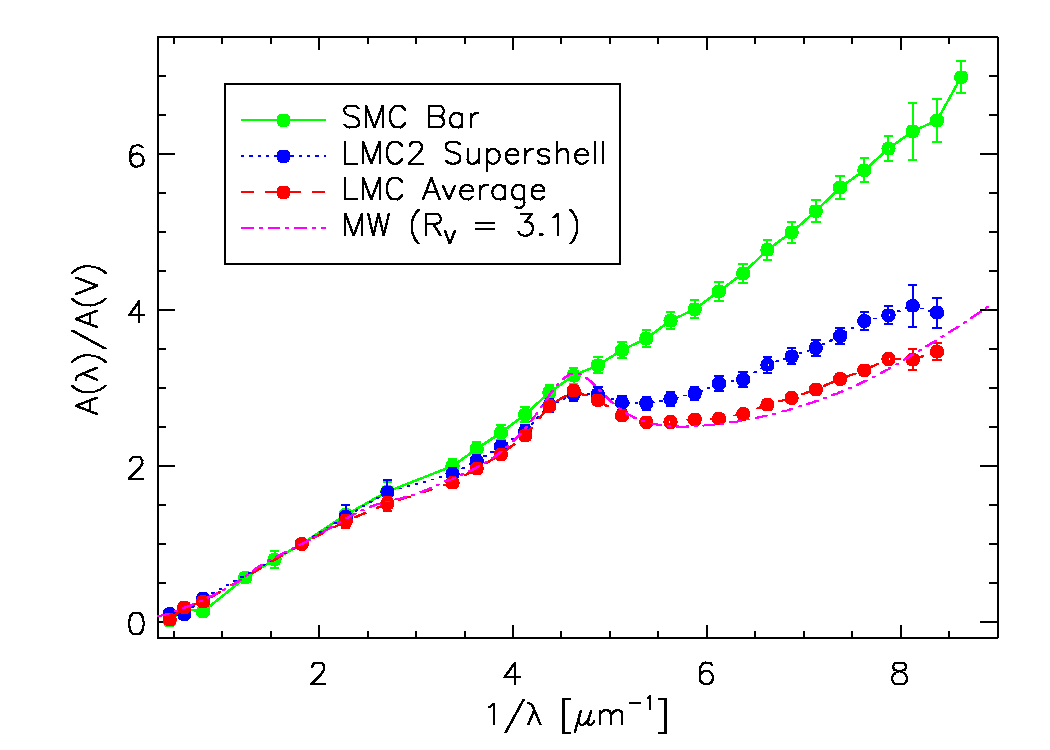Berkeley’s Moving Universe Lab, led by Prof. Jessica Lu @ AC Berkeley focuses on the study of stars and black holes in the nearby universe.
My research primarily deals with determining the extinction law of the Galactic Center, the region of stars in the center of the milky way near Sagittarius A*.
Extinction
Interstellar extinction occurs when light, during its transit between some emitting astronomical object and earth, gets scattered by intermediary dust and gas particles.
As different wavelengths of light scatter differently when encountering the same interstellar dust and gas, astronomers create extinction laws to predict the amount of extinction as a function of wavelength.

Shown above is the average extinction law for the MW, LMC2, LMC, and SMC Bar. The curves are additionally plotted versus $1/\lambda$ to emphasize the UV.
Red Clump (RC) Method
Of course, there are many ways to try and predict the extinction law of a star cluster, each with their strengths and weaknesses.
There is the color-difference (CD) method, where extinction curves are determined in the form of ratios of color excesses $E_{\lambda - \lambda_1} / E_{\lambda_2 - \lambda_1}$ as a function of $\lambda^{-1}$. Here $E_{B-V}$ is used as a standard normalization. The absolute extinction $A_{K_S}$ is then derived from the ratios of color excesses. And afterwards we can predict several other $A_{\lambda}$s via the equation
$$ \frac{A_{\lambda}}{E_{B-V}} = \frac{E_{\lambda - V}}{E_{B-V}} + R_V $$
where $R_V = \frac{A_V}{E_{B-V}}$, the ratio of total to selective extinction.
Afterwards the entire extinction curve is extrapolated via some cubic-spline interpolation after knowing some $A_\lambda$’s. Unfortunately, this extrapolation has uncertainty due to the contamination of dust emission, and the possible existence of neutral extinction by grains much larger than the wavelength of observation.
My research utilizes Red Clump (RC) stars to determine the extinction law. RC stars are the equivalent of horizontal-branch stars for a metal-rich population. They have narrow distributions in luminosity and color with a weak dependence on metallicity. They thus occupy a distinct ‘bar’ in the color-magnitude diagram (CMD) and can be used as standard candles of equal distance.
The best part – the slope of the RC bar on the CMD equals the ratio of total to selective extinction $R_{\lambda}$. I utilize this property of RC stars to determine the entire extinction law. This is known as the RC Method, coined by Nishiyama et al.(2006).

Above I plot the CMDs of stars in the Galactic Center between the 1.15µm and 2.12µm wavelengths. The linear ‘streak’ of stars that is shown above the main-sequence track is the RC bar. The slope of the RC bar is the ratio of total to selective extinction.